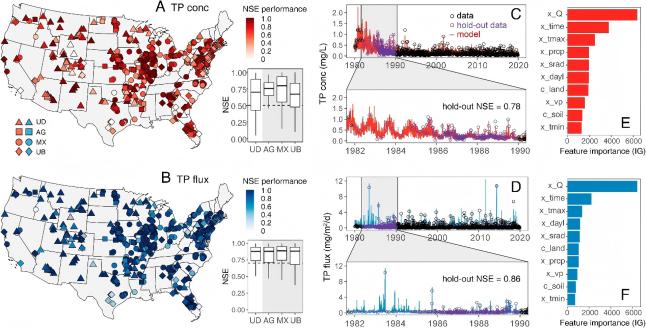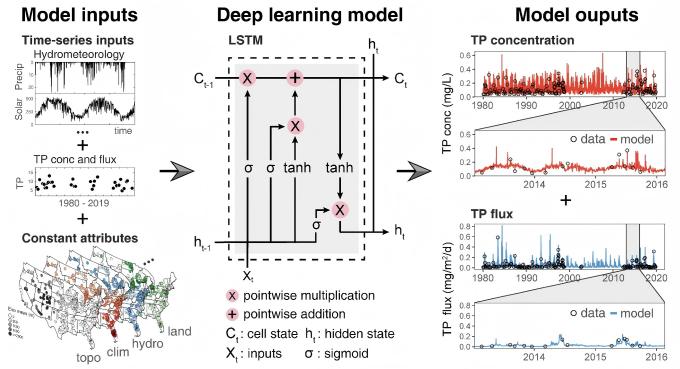Recently, Professor Wei Zhi published a research paper titled “Increasing phosphorus loss despite widespread concentration decline in US rivers” in the Proceedings of the National Academy of Sciences (PNAS). The study highlights the complexity and long-term challenges of non-point source pollution control under the dual influence of climate change and human activities.
Phosphorus (P), essential for all life on Earth, is a nonrenewable resource with limited geological reserves. P loss from land to rivers has contributed to widespread eutrophication, posing serious threats to aquatic ecosystems, soil fertility, and global food security. Due to the limitations of traditional water quality monitoring, such as data scarcity, low spatial and temporal resolution, and inconsistency, it has long been challenging to systematically analyze long-term trends and driving factors of total phosphorus at the national scale.
Using large-scale hydrological datasets and deep learning models, the study simulated and reconstructed daily total phosphorus (TP) concentrations and fluxes over the past 40 years (1980–2019) across 430 river basins (Figure 1). It reveals a significant decline in TP concentrations in urban rivers, despite continued urban population growth, demonstrating the effectiveness of point source pollution control. Conversely, TP concentrations in agricultural areas have generally risen, reflecting challenges in managing non-point source pollution. TP concentrations have decreased in 60% of river basins, yet riverine TP fluxes have continued to rise by 6.5% per decade, driven by increasing runoff associated with climate change. This pattern underscores the complexity and long-term challenges of managing non-point source pollution in a changing climate.

Figure 1. Model performance, example time-series, and feature importance for TP concentrations and fluxes.
Drawing on prior research (see related publications below), the team integrated meteorological, hydrological, and watershed-scale big data with a multi-task deep learning model (Figure 2), overcoming long-standing limitations related to data scarcity and resolution in phosphorus monitoring. This approach enabled daily, long-term simulations of TP concentration and flux at the national scale. The study uncovered distinct long-term trends and seasonal variations of TP across various river types, offering new insights into pollution control and informing more effective watershed management strategies. Furthermore, by applying model interpretation techniques, the researchers identified climate-driven increases in runoff as the dominant factor behind the continued rise in TP flux. These findings underscore the amplifying effect of climate change on non-point source pollution and highlight the urgent need for stronger watershed-based interventions.

Figure 2. A diagram of Long-short Term Memory (LSTM) model with inputs and outputs.
Hohai University is the lead institution of the study. Contributing affiliations include the National Key Laboratory of Water Disaster Prevention, Yangtze Institute for Conservation and Development, Key Laboratory of Hydrologic-Cycle and Hydrodynamic-System of Ministry of Water Resources, and College of Hydrology and Water Resources.
https://www.pnas.org/doi/10.1073/pnas.2402028121
Related Publications:
1. Zhi, W., Klingler, C., Liu J., & Li, L. (2023). Widespread deoxygenation in warming rivers. Nature Climate Change, 13(10), 1105-1113. https://doi.org/10.1038/s41558-023-01793-3
2. Zhi, W., Appling, A.P., Golden, H.E., Podgorski, J., & Li, L. (2024). Deep learning for water quality. Nature Water, 2, 228–241. https://doi.org/10.1038/s44221-024-00202-z
3. Zhi, W., Ouyang, W., Shen, C., & Li, L. (2023). Temperature outweighs light and flow as the predominant driver of dissolved oxygen in US rivers. Nature Water, 1(3), 249-260. https://doi.org/10.1038/s44221-023-00038-z


